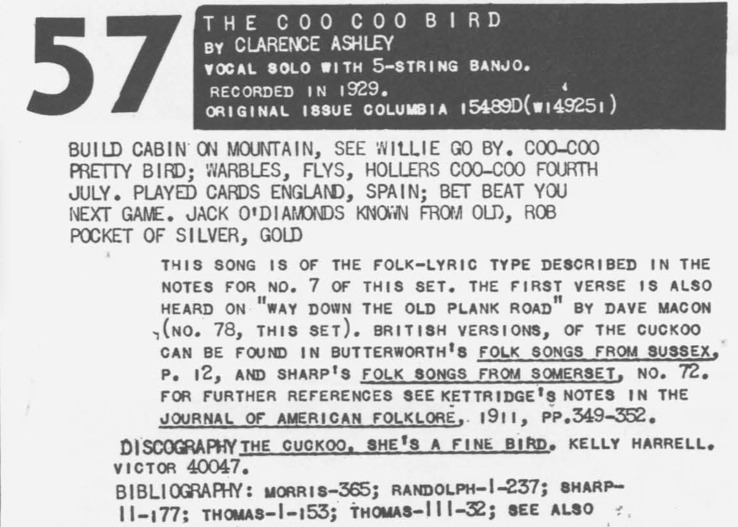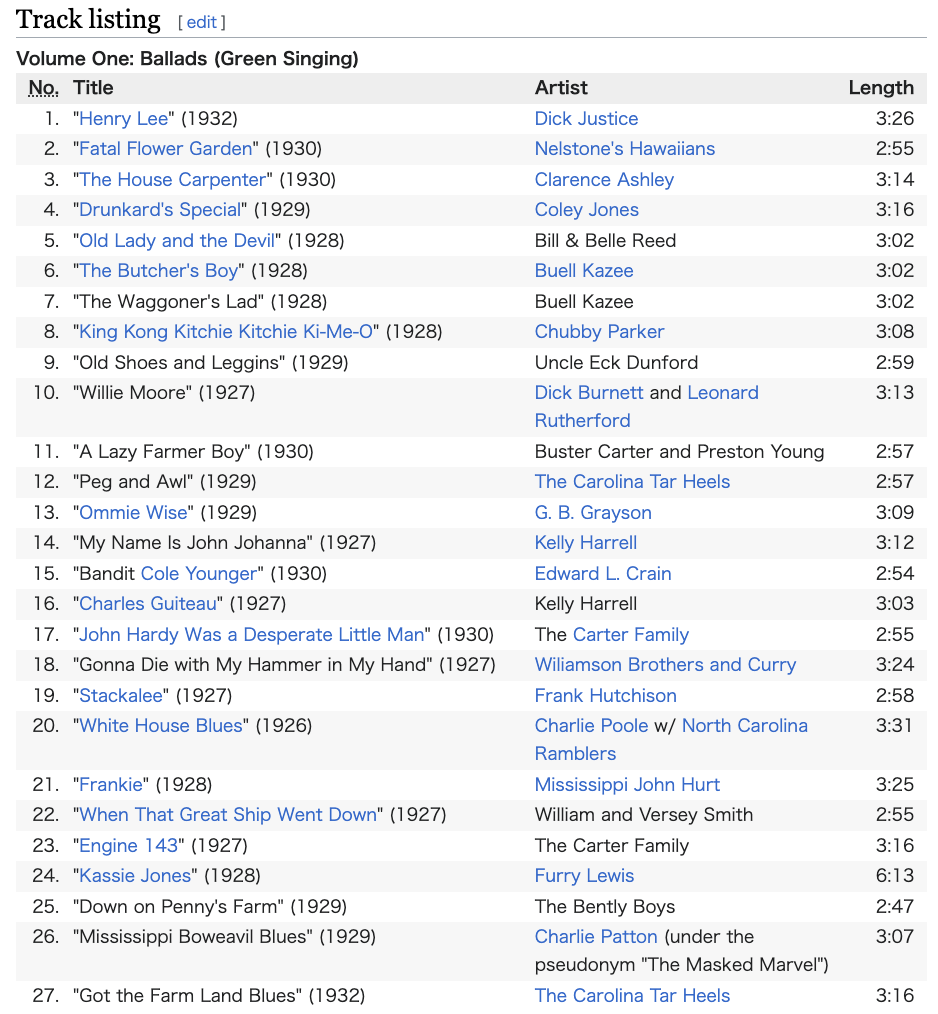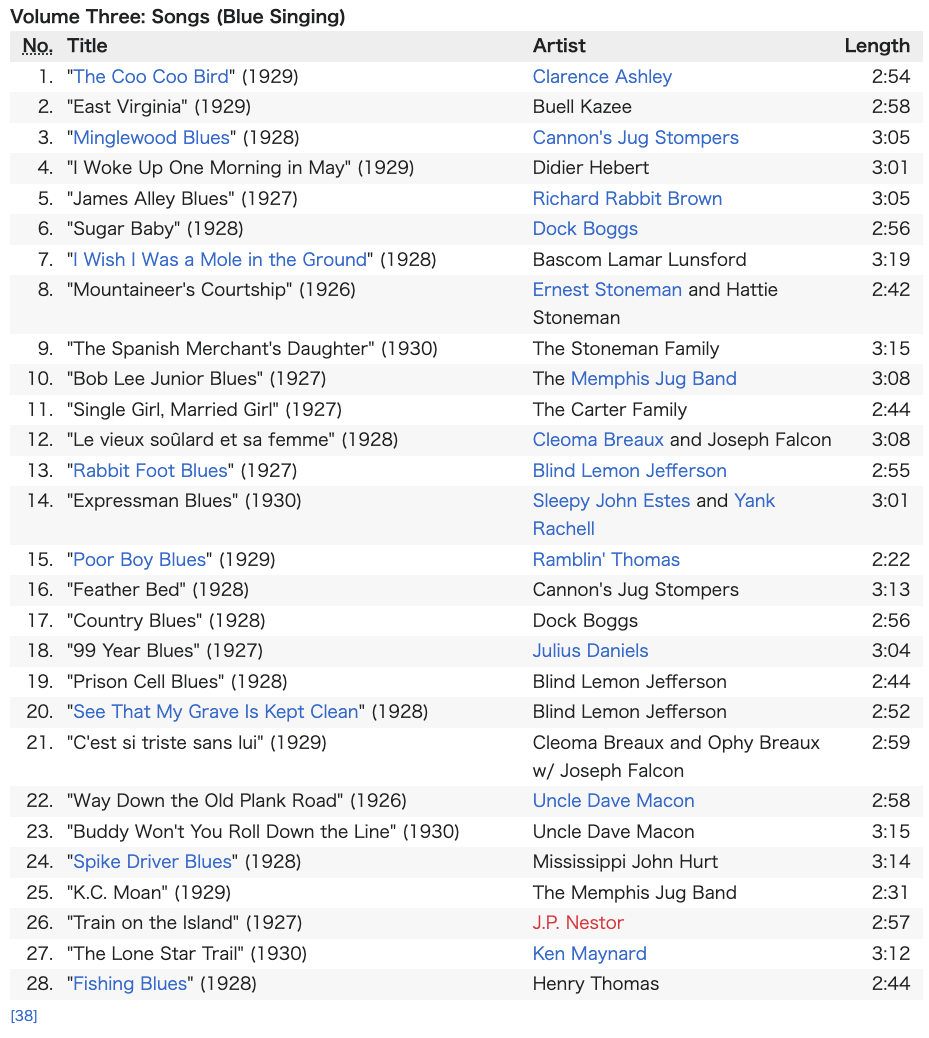

北米のフォーク・ミュージック・アンソロジー
Anthology of American Folk Music, ア ンソロジー・オブ・アメリカン・フォーク・ミュージック


☆ 『アンソロジー・オブ・アメリカン・フォーク・ミュージック』(Anthology of American Folk Music)は、1926年から1933年までに様々な演奏家によって作られ、発表されたアメリカン・フォーク、ブルース、カントリー・ミュージックの録 音84曲を収録し、1952年にフォークウェイズ・レコードからリリースされた3枚組のコンピレーション・アルバムである。このアルバムは、実験映画製作 者ハリー・スミスの個人的な78回転レコード・コレクションから編集された。現在では、1950年代から60年代にかけてのアメリカン・フォーク・ミュージック・リバイバルの中で影響を与えた作品であると同時に、アルバム史におけ る画期的なリリースとして一般的に評価されている。2003年、『ローリング・ストーン』誌はこのアルバムを「史上最も偉大な500枚のアルバム」の 276位にランク付けし[3]、2005年にはアメリカ議会図書館によってナショナル・レコーディング・レジストリーに登録された。
| Anthology of American Folk Music
is a three-album compilation, released in 1952 by Folkways Records, of
eighty-four recordings of American folk, blues and country music made
and issued from 1926 to 1933 by a variety of performers. The album was
compiled from experimental film maker Harry Smith's own personal collection of 78 rpm records. Upon its release the Anthology sold relatively poorly and had no notable early coverage besides a minor 1958 mention in Sing Out!. It is now, however, generally regarded as a landmark release in the history of the album as well as an influential release during the 1950s and 1960s American folk music revival. In 2003, Rolling Stone ranked the album at number 276 on their list of The 500 Greatest Albums of All Time,[3] and, in 2005, the album was inducted into the National Recording Registry by the Library of Congress.[4] |
『ア
ンソロジー・オブ・アメリカン・フォーク・ミュージック』(Anthology of American Folk
Music)は、1926年から1933年までに様々な演奏家によって作られ、発表されたアメリカン・フォーク、ブルース、カントリー・ミュージックの録
音84曲を収録し、1952年にフォークウェイズ・レコードからリリースされた3枚組のコンピレーション・アルバムである。このアルバムは、実験映画製作
者ハリー・スミスの個人的な78回転レコード・コレクションから編集された。 アンソロジーの発売当初の売れ行きは比較的芳しくなく、1958年に『シング・アウト!』でわずかに取り上げられた以外、目立った報道はなかった。しかし 現在では、1950年代から60年代にかけてのアメリカン・フォーク・ミュージック・リバイバルの中で影響を与えた作品であると同時に、アルバム史におけ る画期的なリリースとして一般的に評価されている。2003年、『ローリング・ストーン』誌はこのアルバムを「史上最も偉大な500枚のアルバム」の 276位にランク付けし[3]、2005年にはアメリカ議会図書館によってナショナル・レコーディング・レジストリーに登録された[4]。 |
| Background Harry Smith was a West Coast filmmaker, magickian, bohemian, and eccentric.[5] As a teenager he started collecting old blues, jazz, country, Cajun, and gospel records and accumulated a large collection of recordings,[6] 78s being the only medium at the time. In 1947, he met with Moses Asch, with an interest in selling or licensing the collection to Asch's label, Folkways Records.[7] Smith wrote that he selected recordings from between "1927, when electronic recording made possible accurate music reproduction, and 1932, when the Great Depression halted folk music sales."[8] When the Anthology was released, neither Folkways nor Smith possessed the licensing rights to these recordings, many of which had initially been issued by record companies that were still in existence, including Columbia and Paramount. The anthology thus technically qualifies as a high-profile bootleg. Folkways would later obtain some licensing rights, although the Anthology would not be completely licensed until the 1997 Smithsonian reissue.[9] It seems that Folkways founder Moses Asch had a "reputation for releasing copyrighted songs without going through the proper legal channels."[10] |
生い立ち ハリー・スミスは西海岸の映画製作者であり、マジシャン、ボヘミアン、変わり者であった[5]。 10代の頃、古いブルース、ジャズ、カントリー、ケイジャン、ゴスペルのレコードを集め始め、当時唯一のメディアであった78年代のレコードを中心に、膨 大なコレクションを集めた[6]。 1947年、彼はモーゼズ・アッシュと会い、そのコレクションをアッシュのレーベル、フォークウェイズ・レコードに売却するか、ライセンスを供与すること に興味を持った[7]。スミスは、「電子録音によって正確な音楽再生が可能になった1927年から、世界恐慌によってフォーク音楽の販売が停止した 1932年」[8]までの間の録音を選んだと書いている。そのため、このアンソロジーは厳密には高名なブートレグに該当する。フォークウェイズは後にいく つかのライセンス権を得るが、アンソロジーは1997年にスミソニアンから再発されるまで完全にライセンスされることはなかった[9]。 フォークウェイズの創設者であるモーゼズ・アッシュは、「適切な法的手続きを経ずに著作権のある曲をリリースすることに定評があった」ようだ[10]。 |
| The
compilation was divided by Smith into three two-album volumes:
"Ballads," "Social Music," and "Songs." As the title indicates, the
first "Ballads" volume consists of ballads, including many American
versions of Child Ballads originating from the English folk tradition.
Each song tells a story about a specific event or time, and Smith may
have made some effort to organize to suggest a historical narrative, a
theory suggested by the fact that many of the first songs in this
volume are old English folk ballads, while the closing songs of the
volume deal with the hardships of being a farmer in the 1920s. The first album in the "social music" volume largely consists of music that was likely performed at social gatherings or dances, with many of the songs being instrumentals. The second album in the "Social Music" volume consists of religious and spiritual songs, including some Gospel songs. The third "Songs" volume consists of regular songs, dealing with everyday life. Critic Greil Marcus describes its thematic interests as being "marriage, labor, dissipation, prison, and death."[11] Smith's booklet in the original release makes reference to three additional planned volumes in the series, which would anthologize music up until 1950.[8] Although none were released during his lifetime, a fourth volume was released posthumously in 2000.[12] Entitled "Labor Songs", this volume is themed around songs about work and mainly featured union songs. The album contains later material then the original three volumes, anthologizing material recorded as late as 1940. |
こ
のコンピレーションは、スミスによって3つの2枚組アルバムに分けられた:
「バラッド」、「社交音楽」、「歌曲」である。タイトルが示すように、最初の "Ballads
"巻はバラッドで構成されており、その中にはイギリス民謡に由来するチャイルド・バラッドのアメリカ版も多く含まれている。各曲は特定の出来事や時代につ
いての物語を語っており、スミスは歴史的な物語を示唆するために整理する努力をしたのかもしれない。この巻の最初の曲の多くが古いイギリス民謡のバラッド
である一方、巻の終わりの曲は1920年代の農民としての苦労を扱っているという事実が示唆する説である。 社交音楽」の1枚目のアルバムは、社交の場やダンスで演奏されたと思われる音楽が中心で、インストゥルメンタル曲が多い。社交音楽」の2枚目のアルバムは、ゴスペルを含む宗教的、スピリチュアルな曲で構成されている。 3枚目の "Songs "は、日常生活を歌った普通の曲で構成されている。批評家のグレイル・マーカスは、そのテーマ的関心を「結婚、労働、散逸、刑務所、死」と表現している[11]。 スミスが生前にリリースされたものはなかったが、2000年に死後第4巻がリリースされた[12]。 労働の歌」と題されたこの巻は、労働に関する歌がテーマとなっており、主に労働組合の歌がフィーチャーされている。このアルバムには、オリジナルの3巻よ りも後の音源が収録されており、1940年末に録音された音源がアンソロジ化されている。 |
Design Track 57 description from Harry Smith's Liner Notes Booklet Example from Smith's Liner Notes: #57 – The Coo Coo Bird The design of the anthology was edited and directed by Smith himself. He created the liner notes himself, and these notes are almost as well known as the music, using an unusual fragmented, collage method that presaged some postmodern artwork. Smith also penned short synopses of the songs in the collection, which read like newspaper headlines—for the song "King Kong Kitchie Kitchie Ki-Me-O" by Chubby Parker, a song about a mouse marrying a frog, Smith notes: "Zoologic Miscegeny Achieved Mouse Frog nuptials, Relatives Approve."[13] Each of the three two-record sets carried the same cover art, a Theodore de Bry etching of an instrument Smith referred to as the "Celestial Monochord,"[14] taken from a mystical treatise by scientist/alchemist Robert Fludd. This etching was printed over against a different color background for each volume of the set: blue, red and green. Smith had incorporated both the music and the art into his own unusual cosmology, and each of these colors was considered by Smith to correspond to an alchemical classical element: Water, Fire, and Air, respectively. The fourth 'Labour' volume (released later by Revenant) is colored yellow to represent the element earth. |
デザイン ハリー・スミスのライナーノーツ・ブックレットよりトラック57の解説 スミスのライナーノーツより #57「クー・クー・バード このアンソロジーのデザインは、スミス自身が編集とディレクションを担当した。ライナーノーツは彼自身が作成し、ポストモダンのアートワークを予感させる ような、断片的なコラージュという珍しい手法で、音楽と同じくらいよく知られている。チャビー・パーカーの "King Kong Kitchie Kitchie Ki-Me-O" という曲は、ネズミがカエルと結婚する歌で、スミスはこう記している: 「Zoologic Miscegeny Achieved Mouse Frog nuptials, Relatives Approve」[13]。 3枚のレコード2枚組のジャケット・アートはどれも同じで、スミスが「天空のモノコード」と呼ぶ、科学者/錬金術師ロバート・フラッドによる神秘的な論文 から引用した楽器のセオドア・デ・ブライのエッチングだった[14]。このエッチングは、青、赤、緑というセット各巻ごとに異なる色の背景に重ねて印刷さ れた。スミスは音楽と芸術の両方を彼自身の変わった宇宙観に取り込んでおり、これらの色はそれぞれ錬金術の古典的要素に対応すると考えていた: それぞれ水、火、空気である。後にレヴェナント社から発売される第4巻「Labour」は、元素「土」を表す黄色で彩られている。 |
Release and reissues Cover for 1960s reissue Folkways FA 2951, featuring a poor Depression-era farmer The Anthology was originally released as three double-LP box sets on August 9, 1952.[15] It sold relatively poorly when it was first released – by 1953, Folkways had sold only fifty albums, forty-seven of which went to libraries and colleges – and for a time, it was out of print because of copyright issues.[10] One of the first notable reissues was in the 1960s, released as three individual volumes like the original release. Irwin Silber replaced Smith's covers with a Ben Shahn photograph of a poor Depression-era farmer, over Smith's objections, although others have considered this a wise commercial choice in the politically charged atmosphere of the folk movement during that decade.[16] In 1997, Smithsonian Folkways Recordings, having acquired Folkways Records in 1986, reissued the collection on six compact discs, each disc corresponding to each album of the original set on vinyl, including replicas of Smith's original artwork and liner booklet. An additional booklet included expanded track information for each song by Jeff Place, excerpts from Invisible Republic by Greil Marcus, essays by Jon Pankake, Luis Kemnitzer, Moses Asch, and Neil Rosenberg, and tributes and appreciations by John Fahey, John Cohen, Elvis Costello, Peter Stampfel, Lucy Sante, Dave Van Ronk, Eric Von Schmidt, Chuck Pirtle, and Allen Ginsberg. The back cover to this booklet closes with a quote by Smith: "I'm glad to say that my dreams came true. I saw America changed through music." At the 40th Grammy Awards, the reissue won awards for Best Album Notes and Best Historical Album.[17] In 2006, Shout! Factory and the Harry Smith Archive released a tribute album titled The Harry Smith Project: The Anthology of American Folk Music Revisited, a 2-CD/2-DVD box set culled from a series of concerts staged by Hal Willner that took place in 1999 and 2001.[18] The album features artists such as Beck, Nick Cave, Elvis Costello, Steve Earle, Beth Orton, Lou Reed, Sonic Youth, Richard Thompson, Wilco and others, covering the songs of the original anthology. In 2020, Dust-to-Digital released a compilation containing the B-Sides of the records included on the Anthology entitled The Harry Smith B-Sides. Some songs were not included due to the racist or offensive nature of the lyrics,[19] which drew criticism from reviewers.[20] |
リリースと再発行 1960年代リイシューのジャケット 大恐慌時代の貧しい農民をフィーチャーしたフォークウェイズFA 2951 アンソロジーは当初、1952年8月9日に3枚の2枚組LPのボックスセットとしてリリースされた[15]。リリース当初は比較的売れ行きが悪く、1953年までにフォークウェイズが売ったアルバムはわずか50枚で、そのうち47枚は図書館や大学に送られた。 最初の注目すべき再発のひとつは1960年代で、オリジナル・リリースと同じように3つの個別のボリュームとしてリリースされた。アーウィン・シルバーは スミスの反対を押し切り、スミスのカバーを大恐慌時代の貧しい農民を写したベン・シャーンの写真に差し替えたが、この10年間のフォーク・ムーブメントの 政治的な雰囲気の中で、これは賢明な商業的選択だったと考える人もいる[16]。 1997年、1986年にフォークウェイズ・レコードを買収したスミソニアン・フォークウェイズ・レコーディングスは、スミスのオリジナル・アートワーク とライナー・ブックレットのレプリカを含む、レコードのオリジナル・セットの各アルバムに対応した6枚のコンパクト・ディスクでこのコレクションを再発し た。追加ブックレットには、ジェフ・プレイスによる各曲の拡張トラック情報、グレイル・マーカスによる『Invisible Republic』からの抜粋、ジョン・パンカケ、ルイス・ケムニッツァー、モーゼス・アッシュ、ニール・ローゼンバーグによるエッセイ、ジョン・フェイ ヒー、ジョン・コーエン、エルヴィス・コステロ、ピーター・スタンプフェル、ルーシー・サンテ、デイヴ・ヴァン・ロンク、エリック・フォン・シュミット、 チャック・パートル、アレン・ギンズバーグによるトリビュートと感謝の言葉が掲載されている。このブックレットの裏表紙は、スミスの言葉で締めくくられて いる。音楽を通してアメリカが変わるのを見た" 第40回グラミー賞では、この再発盤は最優秀アルバム・ノート賞と最優秀ヒストリカル・アルバム賞を受賞した[17]。 2006年、シャウト!ファクトリーとハリー・スミス・アーカイブは、『ハリー・スミス・プロジェクト』というトリビュート・アルバムをリリースした: このアルバムには、ベック、ニック・ケイヴ、エルヴィス・コステロ、スティーヴ・アール、ベス・オートン、ルー・リード、ソニック・ユース、リチャード・ トンプソン、ウィルコなどのアーティストが参加し、オリジナルのアンソロジーの楽曲をカバーしている[18]。 2020年、Dust-to-Digitalはアンソロジーに収録されたレコードのB面を集めたコンピレーション『The Harry Smith B-Sides』をリリースした。歌詞に人種差別的なものや攻撃的なものが含まれていたため、収録されなかった曲もあり[19]、批評家から批判を浴びた [20]。 |
| Writing
for AllMusic, critic John Bush wrote the compilation "could well be the
most influential document of the '50s folk revival. Many of the
recordings that appeared on it had languished in obscurity for 20
years, and it proved a revelation to a new group of folkies, from Pete
Seeger to John Fahey to Bob Dylan... Many of the most interesting
selections on the Anthology, however, are taken from [obscure]
artists... such as Clarence Ashley, Bascom Lamar Lunsford, and Buell
Kazee."[21] In his review for The Village Voice, music critic Robert
Christgau wrote "Harry Smith's act of history... aces two very '90s
concepts: the canon that accrues as rock gathers commentary, and the
compilations that multiply as labels recycle catalogue. In its time, it
wrested the idea of the folk from ideologues and ethnomusicologists by
imagining a commercial music of everyday pleasure and alienation—which
might as well have been conceived to merge with a rock and roll that
didn't yet exist... Somebody you know is worth the 60 bucks it'll run
you. So are you."[26] Jon Pareles, writing in The New York Times, said
that the songs "still sound marvelous and uncanny."[27] In 2003, the album was ranked number 276 on Rolling Stone magazine's list of the 500 greatest albums of all time, and 278 in a 2012 revised list.[3] It is the earliest-released album on that list and also includes the oldest recordings (dating back to Uncle Dave Macon's recording of "Way Down the Old Plank Road" in April 1926). In 2005 the album was inducted into the National Recording Registry by the Library of Congress for being "culturally, aesthetically, or historically significant".[4] In 2007, the album was listed in The Guardian's list of 1000 Albums to Hear Before You Die.[28] The album was included in the 2008 book 1000 Recordings to Hear Before You Die,[29] as well as the 2009 book 101 Albums That Changed Popular Music.[30] In 2012, the album was inducted into the Grammy Hall of Fame.[31] Though relatively little was written about the Anthology during the first years after release (the first known press reference to the collection was in the folk music magazine Sing Out! in 1958, which focused on Clarence Ashley’s "The Coo Coo")[32] musicians and writers relate how much of an impact it had on them at the time.[33] The music on the compilation provided direct inspiration to much of the emergent folk music revival movement. The anthology made available music which previously had been largely the preserve of marginal social economic groups. Many people who first heard this music through the Anthology came from very different cultural and economic backgrounds from its original creators and listeners. Many previously obscure songs became standards at hootenannies and folk clubs due to their inclusion on the Anthology. Some of the musicians represented on the Anthology saw their musical careers revived, and made additional recordings and live appearances. This release is generally thought to have been massively influential on the folk & blues revival of the 1950s and 1960s, and brought the works of Blind Lemon Jefferson, Mississippi John Hurt, Dick Justice and many others to the attention of musicians such as Bob Dylan and Joan Baez. The "Harry Smith Anthology," as some call it, was the bible of folk music during the late 1950s and early 1960s Greenwich Village folk scene. As stated in the liner notes to the 1997 reissue, the late musician Dave van Ronk had earlier commented that "we all knew every word of every song on it, including the ones we hated."[34] The Anthology has had major historical influence. Smith's method of sequencing tracks, along with his inventive liner notes, called attention to the set.[35] This reintroduction of near-forgotten popular styles of rural American music from the selected years to new listeners had impact on American ethnomusicology and was both directly and indirectly responsible for the American folk music revival.[36] Sing Out! published a full article on the whole release in 1969.[32] In surveying the critical writing on the Anthology, Rory Crutchfield writes, "[t]his is one of the strangest aspects of the critical heritage of the Anthology: its emergence from relative obscurity to prominence as a revivalist manifesto without much transition. In terms of academic credibility, this partly came from the work of [Robert] Cantwell and [Greil] Marcus, which was published fairly close to the reissue of the collection."[37] https://en.wikipedia.org/wiki/Anthology_of_American_Folk_Music |
オー
ル・ミュージック誌に寄稿した評論家ジョン・ブッシュは、このコンピレーションを「50年代フォーク・リバイバルの最も影響力のあるドキュメントになるだ
ろう」と書いている。ピート・シーガーからジョン・フェイヒー、ボブ・ディランに至るまで、このコンピレーションに収録された音源の多くは20年もの間、
無名のまま眠っていた。しかし、『アンソロジー』に収録されている最も興味深いセレクションの多くは、クラレンス・アシュレイ、バスコム・ラマー・ランス
フォード、ビューエル・カジーといった[無名の]アーティストから選ばれている」[21]
音楽評論家のロバート・クリストガウは、『ヴィレッジ・ヴォイス』誌の批評で「ハリー・スミスの歴史的行為は......まさに90年代的な2つのコンセ
プト、すなわち、ロックが解説を集めることで生まれるカノンと、レーベルがカタログを再利用することで増えるコンピレーションを巧みに表現している」と書
いている。当時は、日常の喜びと疎外感を表現する商業音楽を想像することで、イデオローグや民族音楽学者たちからフォークのアイデアを奪い取ったが、それ
はまだ存在しなかったロックンロールと融合するために考案されたようなものだった...。あなたが知っている誰かには、60ドル払う価値がある。ニュー
ヨーク・タイムズ』紙に寄稿したジョン・パレルスは、この曲は「今でも素晴らしく、不気味に聴こえる」と述べている[27]。 2003年、このアルバムはローリング・ストーン誌の「史上最高のアルバム500枚」で276位、2012年に改訂されたリストでは278位にランクイン した[3]。このリストでは最も早くリリースされたアルバムであり、最も古い録音(1926年4月にアンクル・デイヴ・メイコンが録音した「Way Down the Old Plank Road」に遡る)も含まれている。2005年、このアルバムは「文化的、審美的、または歴史的に重要」であるとして、米国議会図書館によってナショナ ル・レコーディング・レジストリーに登録された[4]。 2007年、このアルバムはガーディアン紙による「死ぬまでに聴きたい1000枚のアルバム」リストに掲載された[28]。 リリース後の最初の数年間、アンソロジーについて書かれたものは比較的少なかったが(同コレクションについて初めて報道されたのは1958年のフォーク音 楽雑誌『シング・アウト!』で、クラレンス・アシュレイの「ザ・クー・クー」に焦点を当てたものだった)[32]、ミュージシャンや作家たちは、同コンピ レーションが当時の彼らにどれほどの影響を与えたかを語っている[33]。このアンソロジーによって、それまでは社会経済的に疎外されたグループのもので あった音楽が入手できるようになった。アンソロジーを通じて初めてこの音楽を耳にした多くの人々は、そのオリジナルの制作者やリスナーとはまったく異なる 文化的・経済的背景を持っていた。アンソロジーに収録されたことで、それまで無名だった曲の多くがフーテナニーやフォーク・クラブのスタンダードとなっ た。アンソロジーに収録されたミュージシャンの中には、音楽的キャリアを復活させ、追加録音やライブ出演を果たした者もいる。このリリースは一般的に、 1950年代と1960年代のフォーク&ブルース・リバイバルに多大な影響を与えたと考えられており、ブラインド・レモン・ジェファーソン、ミシシッピ・ ジョン・ハート、ディック・ジャスティス、その他多くのミュージシャンの作品を、ボブ・ディランやジョーン・バエズなどのミュージシャンの目に留まるよう にした。一部で「ハリー・スミス・アンソロジー」と呼ばれるこのアルバムは、1950年代後半から1960年代初頭にかけてのグリニッジ・ヴィレッジ・ フォーク・シーンにおけるフォーク・ミュージックのバイブルだった。1997年のリイシューのライナーノーツにあるように、ミュージシャンの故デイブ・ ヴァン・ロンクは以前、「嫌いな曲も含めて、そこに収録されているすべての曲のすべての単語を知っていた」とコメントしていた[34]。 アンソロジーは歴史的にも大きな影響を与えた。スミスの曲順の付け方は、彼の独創的なライナーノーツとともに、このセットへの注目を集めた[35]。 選ばれた時代から忘れ去られようとしていたポピュラーなスタイルのアメリカの田舎町の音楽を、新しいリスナーに再び紹介したことは、アメリカの民族音楽学 に影響を与え、アメリカン・フォーク・ミュージックの復興に直接的・間接的に貢献した[36]。 『シング・アウト!』は1969年に全リリースに関する記事を掲載した[32]。 ローリー・クラッチフィールドは『アンソロジー』に関する批評的文章を調査する中で、「『アンソロジー』の批評的遺産の最も奇妙な側面のひとつは、比較的 無名な状態から、さしたる変遷もなくリヴァイヴァリストのマニフェストとして脚光を浴びるようになったことである。学術的な信頼性という点では、これは部 分的に、この作品集の再発行とかなり近い時期に出版された[ロバート・]キャントウェルと[グレイル・]マーカスの仕事から来ている」[37]。 |
| Production personnel Moses Asch: Liner Notes, Transfers Peter Bartok: Transfers Joe Bussard: Transfers Philip Coady: Producer Pat Conte: Transfers Evelyn Esaki: Art Direction John Fahey: Liner Notes David Glasser: Mastering, Audio Restoration Amy Horowitz: Executive Producer, Reissue Producer Luis Kemnitzer: Liner Notes Kip Lornell: Liner Notes Michael Maloney: Producer, Production Coordination Greil Marcus: Liner Notes Mary Monseur: Producer, Production Coordination Steve Moreland: Producer Jon Pankake: Liner Notes Charlie Pilzer: Mastering, Audio Restoration, Transfers Chuck Pirtle: Liner Notes Jeff Place: Liner Notes, Reissue Producer, Transfers, Annotation Pete Reiniger: Mastering, Transfers, Compilation Producer Neil V. Rosenberg: Liner Notes Lucy Sante: Liner Notes Peter Seitel: Editing Harry Smith: Producer, Editorial Stephanie Smith: Research Peter Stampfel: Liner Notes Alan Stoker: Transfers Scott Stowell: Art Direction, Design Jack Towers: Transfers Eric Von Schmidt: Liner Notes |
 |
 |
 |
| ■これを聴かずにアメリカ音楽を語るなかれ! 1952年から現在まで〈アメリカ音楽のバイブル〉として親しまれてきた名盤中の名盤!! 映像作家/コラージュ絵画作家/SPレコード蒐集家としても知られたハリー・スミス(1923-91)という好事家が、1920〜30年代に発売された SPレコードから音源を集め、スミソニアン・フォークウェイズの前身であるフォークウェイズ・レコーズから2LP×3セットという形で1952年に発売し たアメリカ音楽のアンソロジー作品を、1997年にCD化したのがこのボックス・セットだ。〈アメリカ音楽のバイブル〉としてボブ・ディラン、ライ・クー ダー、タジ・マハール、ジェリー・ガルシア、デイヴ・ヴァン・ロンクetc...といった著名な音楽家が貪るように聴き入り、多大なインスピレイションを 本作から受けたことを公言してきた。そんな本作にはCD6枚のほか、貴重な資料がたくさん掲載されている68ページにおよぶ豪華ブックレットも収録。アメ リカ音楽ファンを自認するなら、絶対に持っていなければならない名盤中の名盤だ。 VOLUME ONE メBALLADSモ(CD1 & CD2)は白人・黒人たちの間で歌い継がれてきた「バラッド」に焦点を当てている。アパラチア山脈周辺で歌われてきたトラッド・ソングをベースに生まれた ヒルビリーがレコード文化とともに人気となった時代の録音を中心に紹介。ディランの「Hard Time in New York」の元となったCD2-11など収録している。 VOLUME TWO メSOCIAL MUSICモ(CD3 & CD4)は、1920〜30年代にSPレコードでリリースされた社会性を帯びた伝統曲などにスポットを当てている。虐げられた労働者の哀しみや生死の尊 厳、そして理不尽な社会生活を歌った内容など。フィドルをメインにしたインストやケイジャン、ブルース、ゴスペル、そしてアメリカの白人バンドの元祖カー ター・ファミリーまで。 VOLUME THREE メSONGSモ(CD5 & CD6)はその名の通り優れたソング=詩(うた)をテーマにした2枚。若き日のボブ・ディランが好んで取り上げていたCD5-1を始め、ビューエル・ケイ ジー、ミシシッピ・ジョン・ハート、スリーピー・ジョン・エステス、ドック・ボッグスらによる素晴らしいトラックを収録。後のフォーク・リヴァイヴァル・ ムーヴメントへと繋がる重要な音源が満載だ。 ●日本語による簡単な説明を商品の外装部分に添付して発送いたします。日本語解説は同封しておりません。予めご了承ください。 【6CD】 ■Volume One: Ballads (Green Singing) ・DISC1:"Henry Lee" (1932)/Dick Justice ほか14曲収録 ・DISC2:"Bandit Cole Younger" (1930)/Edward L. Crain ほか13曲収録 ■Volume Two: Social music (Red Singing) ・DISC1:"Sail Away Lady" (1926)/Uncle Bunt Stephens ほか14曲収録 ・DISC2:"Must Be Born Again" (1927) /Rev. J. M. Gates ほか15曲収録 ■Volume Three: Songs (Blue Singing) ・DISC1:"The Coo Coo Bird" (1929)/Clarence Ashley ほか14曲収録 ・DISC2:"Poor Boy Blues" (1929)/Ramblin' Thomas ほか14曲収録 https://x.gd/Mtd8i |
Released
in 1952, The Anthology of American Folk Music was the singular visionof
the enigmatic artist, musicologist, and collector Harry Smith
(1923–1991). Acollection of eighty-fourcommercial recordings of
Americanvernacular and folkmusic originally issued between 1927 and
1932, the Anthology featured an eclecticand idiosyncratic mixture of
blues and hillbilly songs, ballads old and new, dancemusic, gospel, and
numerous other performances less easy to classify. Where previous collections of folk music, both printed and recorded, had privileged field recordings and oral transmission, Smith purposefully shaped his collection from previously released commercial records, pointedly blurring established racial boundaries in his selection and organisation of performances. Indeed, more than just a ground-breaking collection of old recordings, the Anthology was itself a kind of performance on the part of its creator. Over the six decades of its existence, however, it has continued to exert considerable influence on generations of musicians, artists, and writers. It has been credited with inspiring the North American folk revival―"The Anthology was our bible", asserted Dave Van Ronk in 1991, "We all knew every word of every song on it"―and with profoundly influencing Bob Dylan. After its 1997 release on CD by Smithsonian Folkways, it came to be closely associated with the so-called Americana and Alt-Country movements of the late 1990s and early 2000s. Following its sixtieth birthday, and now available as a digital download and rereleased on vinyl, it is once again a prominent icon in numerous musical currents and popular culture more generally. This is the first book devoted to such a vital piece of the large and complex story of American music and its enduring value in American life. Reflecting the intrinsic interdisciplinarity of Smith’s original project, this collection contains a variety of new perspectives on all aspects of the Anthology. 1952年に発売された『The Anthology of American Folk Music』は、謎めいたアーティスト、音楽学者、コレクターのハリー・スミス(1923-1991)の独創的なビジョンだった。このアンソロジーは、 1927年から1932年にかけて発行されたアメリカ民謡とフォーク・ミュージックの商業録音84曲を集めたもので、ブルースやヒルビリーの歌、新旧のバ ラード、ダンス・ミュージック、ゴスペル、その他分類が容易でない数多くの演奏が、折衷的かつ特異な形で収録されている。 印刷されたものであれ、録音されたものであれ、これまでのフォーク・ミュージック・コレクションがフィールド・レコーディングや口伝に特権を与えていたの に対し、スミスは意図的に既発の商業用レコードからコレクションを構成し、演奏の選択と構成において、既成の人種的境界を曖昧にした。実際、アンソロジー は単なる古い録音の画期的なコレクションというだけでなく、それ自体が制作者自身による一種のパフォーマンスであった。 しかし、60年以上もの間、このアンソロジーは何世代ものミュージシャン、アーティスト、作家に多大な影響を与え続けてきた。1991年にデイヴ・ヴァ ン・ロンクが「アンソロジーは我々のバイブルだった」と断言したように、このアルバムは北米フォーク・リバイバルを鼓舞し、ボブ・ディランに多大な影響を 与えたと言われている。1997年にスミソニアン・フォークウェイズからCDがリリースされると、1990年代後半から2000年代前半にかけてのいわゆ るアメリカーナやオルトカントリー・ムーブメントと密接に関連するようになった。60歳の誕生日を迎え、デジタル・ダウンロードやレコードでの再リリース が可能になった今、この曲は再び、数多くの音楽的潮流やポピュラー・カルチャー全般において、傑出したアイコンとなっている。 本書は、アメリカ音楽という大きく複雑な物語の重要な一部分と、アメリカ生活におけるその不朽の価値に捧げられた初めての本である。スミスのオリジナル・ プロジェクトの本質的な学際性を反映し、本コレクションはアンソロジーのあらゆる側面に関する様々な新しい視点を含んでいる。 Ross Hair, Thomas Ruys Smith(eds.) Harry Smith's Anthology of American Folk Music: America changed through music. Routledge, 2017. |
| Part 1: Introductions 1. Introduction: America Changed Through Music Ross Hair and Thomas Ruys Smith 2. ‘spun in a wheel of vertigo’: Harry Smith and the Magic of History Geoff Ward 3. Harry Smith’s Anthology of American Folk Music: The Critical Heritage Rory Crutchfield Interlude 1. "This Unknown Body of Americana": Alan Lomax’s List of American Folk Songs on Commercial Records and the Anthology of American Folk Music Nathan Salsburg Part 2: "The whole bizarre package" 4. Harry Smith, the Anthology, and the Artist as Collector Justin Parks 5. Collage, Politics, and Narrative Approaches to Harry Smith’s Anthology of American Folk Music Dan Blim 6. Harry Smith: Collecting Thought-Forms and Programming the Aerial Computer R. Bruce Elder Part 3: Deep Cuts 7. "Fatal Flower Garden": The Execution of a Child Ballad Robin Purves 8. Smith’s Amnesia Theater: "Moonshiner’s Dance" in Minnesota Kurt Gegenhuber 9. Dead Presidents: "Charles Guiteau", "White House Blues", and the Histories of Smithville Thomas Ruys Smith Interlude 2. How Weird is Folk? Sharron Kraus Part 4: "Other Lives" 10. "Volk Roots and Hiart Leaves": John Fahey and the Anthology of American Folk Music Ross Hair 11. Recycling the South: Contemporary Literature and the Anthology of American Folk Music Phil Langran 12. The "Other Lives" of Harry Smith’s Anthology of American Folk Music Paola Ferrero Afterword Rani Singh. Index |
パート1:イントロダクション 1. はじめに 音楽が変えたアメリカ ロス・ヘア、トーマス・ルイス・スミス 2. 眩暈の輪の中で紡がれる」:ハリー・スミスと歴史の魔法 ジェフ・ウォード 3. ハリー・スミスのアメリカ民俗音楽アンソロジー: 批評的遺産 ローリー・クラッチフィールド 間奏曲1. 「この知られざるアメリカーナの本体」: アラン・ローマックスの商業レコードに収録されたアメリカ民謡リストと『アメリカ民俗音楽アンソロジー』 ネイサン・サルスバーグ 第2部:"奇妙なパッケージ" 4. ハリー・スミス、アンソロジー、そしてコレクターとしてのアーティスト ジャスティン・パークス 5. コラージュ、政治、そしてハリー・スミスの『アメリカ民俗音楽アンソロジー』への物語的アプローチ Dan Blim 6. ハリー・スミス 思考形式の収集と空中コンピュータのプログラミング R. ブルース・エルダー 第3部:ディープ・カット 7. 「運命の花園 ロビン・パーブス:子供向けバラードの処刑 8. スミスの記憶喪失劇場 ミネソタにおける "Moonshiner's Dance" クルト・ゲーゲンフーバー 9. 死んだ大統領たち 「チャールズ・ギトー」、「ホワイトハウス・ブルース」、そしてスミスヴィルの歴史 トーマス・ルイス・スミス 間奏曲2. フォークとはいかに奇妙か?シャロン・クラウス 第4部:"もうひとつの人生" 10. 「ヴォルク・ルーツとハート・リーブス ジョン・フェイヒーとアンソロジー・オブ・アメリカン・フォーク・ミュージック ロス・ヘア 11. 南部のリサイクル 現代文学とアメリカン・フォーク・ミュージック・アンソロジー フィル・ラングラン 12. ハリー・スミスのアメリカ民俗音楽アンソロジーの「もうひとつの人生」 パオラ・フェレーロ あとがき ラニ・シン 目次 |
リ ンク
文 献
そ の他の情報
Copyleft, CC, Mitzub'ixi Quq Chi'j, 1996-2099